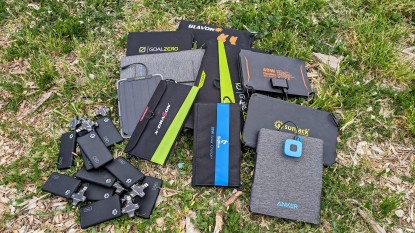JOOS Orange Review
Our Verdict
Our Analysis and Test Results
A slick and weather resistant solar panel, the Joos is a high-tech but on the heavy side for backcountry use.
Output Power
This panel charged our iPhone 5 and iPad as fast as any other panel in our tests. It also performed well in low light. Because it has its own legs, it is easy to position the panel directly perpendicular to the sun. No other panels we tested allow you to do this.
The 5400 mAh battery is pretty generous and will charge most smart phones 2+ times. You can pre-charge the battery from your computer, a wall socket or your car if you have a USB adapter for your 12V cigarette lighter or a USB connection. If you have a PC, you can also plug this panel in and get a readout on how charged the internal battery is.
Ease of Use
Unlike most panels we tested, this panel does not have a way to directly plug your USB charging cable. Instead, you need to carry the Joos charging cable, then choose the right adapter. It comes with adapters for most smart phones and devices you would want to charge (iPhones 3 and 4, iPad, etc). Ours did not come with an adapter for the iPhone 5 or iPad mini so you have to either buy the lightning adapter for $10 plus shipping or select the USB tip to connect your own USB charging cable (Joos Cable + USB tip + your own USB charging cable). The fact you always need to remember the cable and adapters is a bit of a bummer, especially since there is no built-in case. There is a waterproof ziploc style sleeve and string that comes with the panel that you can leave your adapter in. Joos also sells a case for an additional $30.
Connector Issue
The panel worked great for the first few months but eventually our connection from the Joos charging cable to the panel became less reliable. You would have to gently wiggle the cable back and forth where it connects to the panel and then hope it stayed charging. In reading through the 44 reviews on Amazon, at least five other people had a similar issue with the connector either not being durable or not working at all. We don't feel we were overly hard or abusive on the panel.
Versatility
This panel will charge just about about all electronics except for a laptop. There is only one connector so you can't charge two devices at once unless you buy an additional external battery that has an input and two USB outputs.
This is the only panel we tested with the option to replace the internal battery.
Weight
This is a heavy panel but you are also getting a built-in battery. The weight-per-watt ratio is not great but this also performs much better than its wattage implies. We would consider this panel too heavy to take backpacking, biking, or on a long hike if you are just charging your cell phone.
Conclusion
This is a very durable panel that is ideal for all-weather conditions. It is the best panel for performance in wet conditions where durability is the highest priority. We feel it is too heavy for backpacking or long hikes considering there are other panels that cost and weigh much less. While we recommend this panel, we also feel that many people who are less concerned with water-resistance might be better off buying a much less expensive panel and combine it with an external battery. For example, you could get the InstaPark Mercury 10 and then combine it with a $30-40 10,000 mAh external battery for less than $100 and about the same weight. This setup would also be more versatile in that you could choose to take the panel or the battery or both. For example, it can be nice to take an external battery on a long flight in order to watch movies on your tablet.
Accessories
This is the only panel we tested which comes with optional reflectors (for an extra $25) that boost the efficiency by 50-100 percent called the Power Boost Reflector Kit.




